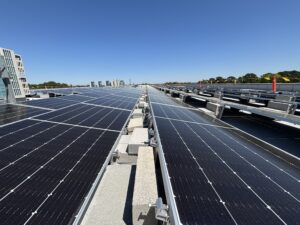Photo: The Wake County Public Health Center distinguishes itself through potentially one of the largest solar installations on a Wake County-owned building. Photo Credit (all): Skanska
By Paul Kelker
When Skanska broke ground on the Wake County Public Health Center, the construction giant launched a project with the potential to be a model for future public health facilities. The 155,000-square-foot center—which will be completed later this year—represents a convergence of healthcare infrastructure and environmental stewardship and positions Wake County to set new standards for public health construction in North Carolina.
As a global leader in sustainable and healthcare construction, Skanska brought decades of experience in green building practices to this transformative project. The company’s commitment to environmental responsibility extends beyond individual projects to encompass comprehensive sustainability goals, including carbon-neutral operations and circular economy principles. This expertise proved invaluable when partnering with forward-thinking clients like Wake County, whose leaders know that public health and environmental health are inextricably linked.
The project, located in Raleigh, represents a significant expansion of the Wake County Health and Human Services Campus.
Leading the Solar Revolution
The Wake County Public Health Center distinguishes itself through potentially one of the largest solar installations on a Wake County-owned building. The building and parking deck harness solar power through 1,290 panels, generating 560 kilowatts of clean energy that will reduce the facility’s grid-dependent energy consumption by nearly 25 percent.
The electricity-generating solar capacity translates into tangible environmental benefits. The system has the potential to offset hundreds of tons of carbon dioxide emissions annually. For a healthcare facility serving thousands of residents throughout the greater Raleigh area, this reduction in environmental impact directly benefits the communities the center serves.
Comprehensive Sustainable Design

While the solar array captures attention, the facility’s commitment to sustainability extends throughout its design and construction. The building incorporates energy-efficient HVAC systems, LED lighting throughout, and advanced building management systems that optimize energy consumption based on occupancy and usage patterns. High-performance windows and enhanced insulation reduce heating and cooling demands, while water-efficient fixtures minimize resource consumption. While concrete historically has higher levels of embodied carbon, recent innovations have resulted in significant improvements. On this project, the addition of recycled carbon in the concrete mixing process was integral in reducing the carbon footprint.
The construction process itself emphasized sustainable practices, including waste reduction strategies, recycling of construction materials and sourcing from local suppliers where possible to reduce transportation-related emissions. These efforts align with Skanska’s broader sustainability initiatives and demonstrate how large-scale construction can minimize environmental impact from groundbreaking through occupancy.
Healthcare Infrastructure for the Future
Beyond sustainability, the facility addresses critical healthcare delivery needs with 88 examination rooms and 20 dental treatment rooms, enabling simultaneous care for more than100 patients. This capacity expansion addresses the growing demand for public health services while maintaining the highest standards of care quality and accessibility as the area continues to experience strong population growth demonstrated by an increase of more than 100,000 new residents since 2020, representing one of the largest growing counties in North Carolina and the nation.
The integration of sustainable features with healthcare functionality creates a healing environment that reflects a modern understanding of wellness. Natural lighting, improved air quality through advanced indoor filtration systems, and reduced noise levels from efficient mechanical systems all contribute to better patient and staff experiences.
Reducing Healthcare’s Carbon Footprint Through Sustainable Design
The healthcare industry is a significant contributor to greenhouse gas emissions, accounting for 8.5% of all emissions in the United States (Shah & Gustafsson, 2024). One crucial approach to mitigating this impact is incorporating sustainability options during the design phase of new construction projects.
Countries worldwide are leading by example in sustainable healthcare infrastructure. Haiti is building the world’s largest solar-powered hospital, Sierra Leone has electrified six major hospitals with solar systems and Myanmar has equipped healthcare centers nationwide with solar panels. These nations demonstrate that healthcare facilities can operate independently of expensive, unreliable power grids while reducing both costs and environmental impact.
The United States is beginning to follow this trend toward more efficient healthcare operations. Forward-thinking healthcare providers like Wake County are emphasizing sustainability and renewable energy to heal both their communities and the environment. Environmentally friendly healthcare operations begin when a project breaks ground, where sustainable procedures have emerged as a primary focus in new development projects, including recycling used materials and incorporating energy-efficient HVAC and lighting systems to further offset environmental impact.
Setting New Standards
The Wake County Public Health Center project demonstrates how public infrastructure and environmental stewardship can work together to better serve communities. By choosing to prioritize sustainability, Wake County is creating a possible model for future healthcare construction projects across the region and beyond.
The project, which began construction in December 2023, amassed more than 535,000 construction hours and included 900 tons of structural steel. With substantial completion scheduled for October 2025, the facility will soon begin serving Wake County residents while simultaneously contributing to regional clean energy goals.
As healthcare facilities rank among the most resource-intensive buildings to construct and operate, projects like the Wake County Public Health Center prove that significant environmental improvements are achievable without compromising functionality or care quality. Through innovative design, strategic partnerships, and commitment to sustainability, this project bridges medical treatment with environmental responsibility, creating a healthier future for the communities it serves.
Paul Kelker is a project executive with Skanska.


